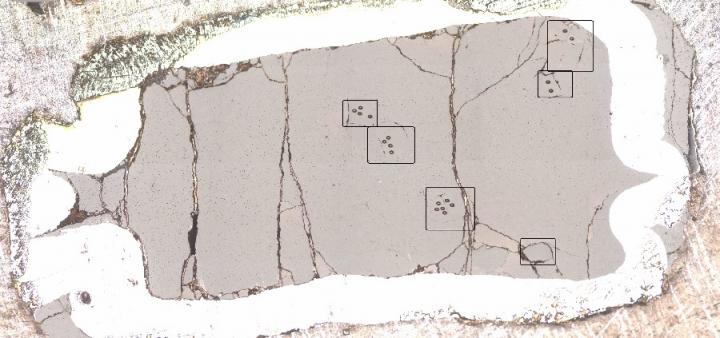Melting temperature of Earth's mantle depends on water

This is an image of one of the team's lab mimicry experiments, which was conducted in a capsule made of gold-palladium alloy. The black boxes highlight the locations of olivine grains, and the dark pits in the olivines are actual measurements for the water content of the olivine. The peridotite is the super fine-grained matrix. Image is courtesy of Emily Sarafian
Earth's mantle, the layer just beneath the crust, is the source of most of the magma that erupts at volcanoes. Minerals that make up the mantle contain small amounts of water, not as a liquid, but as individual molecules in the mineral's atomic structure.
Mid-ocean ridges, volcanic undersea mountain ranges, are formed when these mantle minerals exceed their melting point, become partially molten, and produce magma that ascends to the surface. As the magmas cool, they form basalt, the most-common rock on Earth and the basis of oceanic crust. In these oceanic ridges, basalt can be three to four miles thick.
Studying these undersea ranges can teach scientists about what is happening in the mantle, and about the Earth's subsurface geochemistry.
One longstanding question has been a measurement of what's called the mantle's potential temperature. Potential temperature is a quantification of the average temperature of a dynamic system if every part of it were theoretically brought to the same pressure. Determining the potential temperature of a mantle system allows scientists better to understand flow pathways and conductivity beneath the Earth's crust.
The potential temperature of an area of the mantle can be more closely estimated by knowing the melting point of the mantle rocks that eventually erupt as magma and then cool to form the oceanic crust.
In damp conditions, the melting point of peridotite, which melts to form the bulk of mid-ocean ridge basalts, is dramatically lower than in dry conditions, regardless of pressure. This means that the depth at which the mantle rocks start to melt and well up to the surface will be different if the peridotite contains water, and beneath the oceanic crust, the upper mantle is thought to contain small amounts of water–between 50 and 200 parts per million in the minerals of mantle rock.
So lead author Emily Sarafian of Woods Hole, Carnegie's Erik Hauri, and their team set out to use lab experiments in order to determine the melting point of peridotite under mantle-like pressures in the presence of known amounts of water.
“Small amounts of water have a big effect on melting temperature, and this is the first time experiments have ever been conducted to determine precisely how the mantle's melting temperature depends on such small amounts of water,” Hauri said.
They found that the potential temperature of the mantle beneath the oceanic crust is hotter than had previously been estimated.
“These results may change our understanding of the mantle's viscosity and how it influences some tectonic plate movements,” Sarafian added.
###
The study's other co-authors are Glenn Gaetani and Adam Sarafian, also of Woods Hole.
This research was funded by the National Science Foundation and the Woods Hole Oceanographic Institution's Deep Ocean Exploration Institute.
The Carnegie Institution for Science (carnegiescience.edu) is a private, nonprofit organization headquartered in Washington, D.C., with six research departments throughout the U.S. Since its founding in 1902, the Carnegie Institution has been a pioneering force in basic scientific research. Carnegie scientists are leaders in plant biology, developmental biology, astronomy, materials science, global ecology, and Earth and planetary science.
Media Contact
All latest news from the category: Earth Sciences
Earth Sciences (also referred to as Geosciences), which deals with basic issues surrounding our planet, plays a vital role in the area of energy and raw materials supply.
Earth Sciences comprises subjects such as geology, geography, geological informatics, paleontology, mineralogy, petrography, crystallography, geophysics, geodesy, glaciology, cartography, photogrammetry, meteorology and seismology, early-warning systems, earthquake research and polar research.
Newest articles

Pinpointing hydrogen isotopes in titanium hydride nanofilms
Although it is the smallest and lightest atom, hydrogen can have a big impact by infiltrating other materials and affecting their properties, such as superconductivity and metal-insulator-transitions. Now, researchers from…

A new way of entangling light and sound
For a wide variety of emerging quantum technologies, such as secure quantum communications and quantum computing, quantum entanglement is a prerequisite. Scientists at the Max-Planck-Institute for the Science of Light…

Telescope for NASA’s Roman Mission complete, delivered to Goddard
NASA’s Nancy Grace Roman Space Telescope is one giant step closer to unlocking the mysteries of the universe. The mission has now received its final major delivery: the Optical Telescope…



